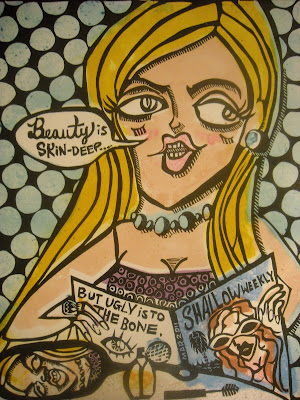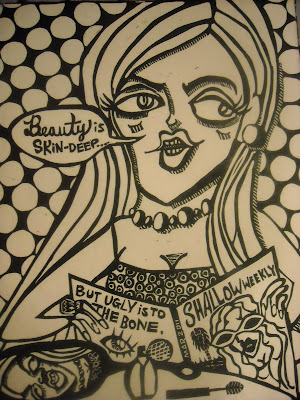Dear Readers:
Dumpy Dolores has come back to the sticker scene and is more fabulous than ever! Today’s entry focuses on a brand new, unprecedented run of 100 full color, glittering Dumpy Dolores stickers.
Dumpy Dolores was created in Spring 2006. Eventually after hanging out with a Philadelphia Graffiti Artist Constituency, Dumpy was branded as a graffiti “tag” that I would put up wherever I went. Graffiti falls mostly into three categories: Paint, wheat paste and stickers. Sometimes the lines are blurred in combining the three, but what we see here are true sticker tags. There is a huge subculture of sticker makers out there in real life and on the internet. It’s fun and addicting, too. Just try going to http://www.flickr.com and search for sticker graffiti.If you'd like to see some old pics of your Dear Aunt Dolores, just search for her by name!
Dumpy Dolores is a punching bag of jokes of vice, gluttony, laziness and being otherwise unkempt. Dumpy lives in our hearts and minds as a reminder of how things could be worse or how great things that are terrible for us are, such as cigarettes and Spam. Yes, Dumpy is aware that food that tastes good is comprised of salt, fat and sugar, which is pretty much all of the ingredients that make Dumpy so delicious herself… that, and 2 packs of menthols a day.
Making sticker graffiti has truly been one of my favorite things about being an artist. I have met and collaborated with amazing artists from all over the world and my art has traveled to far-off lands I can only hope to visit in person myself one day.
 Alas, in April 2009 I was discovered as the leader of this sticker campaign in my hometown of Montclair, NJ where I placed a superfluous amount of stickers within walking distance of my house (and the police station.) The cop who pulled me over immediately recognized 42 Dumpy Dolores stickers on the front seat of my truck. My little art movement cost me a pretty penny. Since then I have not put a single sticker on public property and boy do I miss it. This new generation of stickers is something I hope that will carry on the tradition of sticker tagging and bestow a new era of Dumpy Deliciousness onto the art scene.
Alas, in April 2009 I was discovered as the leader of this sticker campaign in my hometown of Montclair, NJ where I placed a superfluous amount of stickers within walking distance of my house (and the police station.) The cop who pulled me over immediately recognized 42 Dumpy Dolores stickers on the front seat of my truck. My little art movement cost me a pretty penny. Since then I have not put a single sticker on public property and boy do I miss it. This new generation of stickers is something I hope that will carry on the tradition of sticker tagging and bestow a new era of Dumpy Deliciousness onto the art scene. Dumpy Dolores can be found on Facebook where she makes frequent updates about her triumphs and tribulations of being an old rummy with a chest that just won’t quit. Add her today and enjoy some amusing updates in your newsfeed.
As always, many thank-yous for having a look at my blog!
Yours truly,
-Mike
P.S.
If you would like information on how to obtain a Dumpy Dolores sticker, please email me. mheter@gmail.com




































